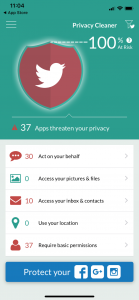Introduction
In 2019, almost all of us live part of our lives online. We do our banking and shopping online, communicate with friends and family, network with colleagues, share photos and videos, study and play games. And all of this leaves a trail behind.
In this post, we’ll be exploring how you can maintain your online safety, and that of your family.
You can read more about working safely online in ‘More Detail’ below, then take a look at the activities under ‘Try’ and finally, share your thoughts and comments with us under ‘Share’.
Try
We have a few activities for you this week. Try as many as you want.
- Search for yourself online. If possible, do this on a computer where you’re not already logged in to your normal accounts (iCloud, Google, etc.). Share in the comments anything you found that surprised you. Allow 15 – 30 minutes.
- Create a MyPermissions account and start taking control of your online privacy. Allow 10 – 15 minutes. Share in the comments anything you found that concerned you.
- Take the technology check-up. Allow 20 minutes.
- Create a Twitter account and follow @23ThingsCDU. Allow 30 minutes to set up a new account.
- If you have children, check out the readwritethink tips and review their online privacy settings with them. Allow up to 1 hour.
More Detail
An interesting exercise is to do a search for yourself online. You might find your name features on your employer’s webpage together with your contact details; you may find news articles and images, your LinkedIn profile, your Facebook posts, Gumtree or eBay listings, Amazon purchase reviews and so much more. How much of that do you really want visible to everyone? And what steps can you take to maintain your online safety, and that of your family?

My Permissions app.
Many of the online tools we use regularly require us to set up a profile including several personal details, and then that profile can be used to simplify the process of signing up for other tools and apps. You can check the app, MyPermissions, to see just how many apps have access to your Twitter or Facebook account. For the record, apparently, I have 37 apps that can access my Twitter account – some that I don’t even know what they are! I’ll be reviewing that this week.
Facebook is, for many, a means of communicating with friends and family overseas or interstate. Have you checked your privacy settings? This is particularly important if you’re sharing photos of your children which may include where they go to school or dance class, play sport, and the names of family pets and other identifying features.
This doesn’t mean we shouldn’t be active online, rather, that we should be careful about how we link our tools and apps, and make deliberate choices about what is public information and what is private. For many of us, our LinkedIn or Twitter accounts and blogs are an important means of developing our professional networks and sharing information, and we’ll be covering more on this in Thing 3 and Thing 5.
Through this program we will be networking through the @23ThingsCDU Twitter account, communicating and sharing with others across Australia and globally. If you’re interested in using Twitter to develop your professional networks, follow these simple instructions on Signing up with Twitter. If you choose to set up an account, you will need to decide on a username: this is how you will be seen online, so select a name that is professionally appropriate. Once you’ve created your account, search for and follow @23ThingsCDU. We’ll cover more on using Twitter in Thing 5.
The Office of the Australian Information Commissioner website contains helpful advice on your privacy when using social media, including:
A 2020 update from the eSafety Commissioner is the Toolkit for Universities, a suite of resources to help university communities be safer online, including resources for teachers and students.
For those with children going online, how to be safe online provides activities assisting teens to create a safe online profile, and to play and stay safe online.
A further resource for parents with teens is The Lost Summer, an educational video game in which players take on the role of various young people within a diverse community. Throughout the game, players are confronted with a variety of challenges, including conflicts on social media, cyber-attacks and fake news. The Lost Summer provides opportunities for participants to develop respect, critical thinking, resilience, responsibility and empathy.
Share
Leave a reply below sharing how you participated in the activities this week.
Was there anything that surprised or concerned you in your searches? What are some of the benefits and risks for you in sharing online? How can you overcome these?
Comments are closed.
References
Banner image: Photo by Johannes Plenio on Unsplash
MyPermissions screenshot by S. Tucker
Thing 2 was written by Sue Tucker, 2019.


Online privacy is a concern of mine. I found the material really insightful and useful (I thought the material for children/teens, was great). I downloaded the MyPermissions app and was quite happy with the results – However, I will be reviewing my settings with Facebook & Spotify, as a result of this!
[Tweeting on @curtinmakers, if you’d like to connect]
I found some time to play:
1. I had no surprises when I googled myself. (I expected to find myself more easily) Strangely people with my name are mostly old, or have old photos up on the net!
2. My permission and tech check up look good. I didn’t not know of them and will look further when I have time. Thank you.
3. I already have too many twitter accounts and I don’t use them often or well. Am i the only one that does not get much value out of twitter?
Thanks Sue and Wendy, great initiative.
That’s good to hear there were no nasty surprises.
You might like to check in for Things 5, 7, 17 and 18 which will all include some Twitter tips. It certainly helps if you work out why you’re using Twitter – so maybe consider that first, then look at just using one account from that point on.
Sue
Some surprises on internet search, a few old memories and different results. Sites like twitter always come up even though havent used it for years. Also found out that (according to names.org) Jaemie is the 74,515th most popular name of all time!
I was amazed how many people share my name. I downloaded the APP no surprises. I use social media very litte. When I downloaded the Twitter account i was almost immeidately locked out for unoffocial behaviour – associated with one of the sites I had chosen to follwo.
The internet is quite good for old memories! Will we say to our friends ‘Remember when Facebook had that memory?’ Look forward to a blog appearing for Thing 3 and moving forwards. Your comment on Thing 2 is part of your participation and can be logged with the form provided in Thing 3.
Part of using social media is getting used to it’s quirks! I hope Twitter forgives you. If you want to follow me on Twitter, look for @wentale or @sueinasp for Sue Tucker. CDU has a number of accounts including @CDU @CDUMedia @CDUni_VC and we are using the tag #CDUnistaff and #23Things for these activities. Hope you can work out Thing 3 and look forward to reading your blog post.
I love reading new information, very informative. Thank you for sharing.
Glad you found it useful, Jasmine. Welcome aboard.
Hello,
I got stuck on Week 2 and thankfully Wendy has got me back on track. When you think about ‘assumed knowledge’ and technology, think “great big black hole’ for me. Each new learning activity comes with more questions than answers. So, thank you to Wendy for the help. This week I have set up a twitter account. I looked at the @23 Things tweets and read through the list of participants. I chose someone to follow and it said “pending”. Does that mean the person has to approve receiving a tweet from me? I’m looking forward to finally saying something intelligent but it could be a long way off……
Joanne
Interestingly, I could not search for my profile online 🙂 or I did not know how to search? I used MyPermissions app and found that there are 3 apps which can access my Facebook account. They are rated at high-risk apps. I know these 3 apps and I did allow them to access my profile on Facebook which I used most of the time. I need to consider removing them out of the list. Thanks for your useful information in Thing 2.
Wow!!! I have found out a boatload of useful resources that help both teaching and learning how to be safe online!!! Thank you for sharing!!!
Thank you very much for designing this informative section.
I did two things: installed and used MyPermissions to scan my Facebook and Gmail accounts, and then finished the survey at Technology Checkup for Phone. I was happy to see the results.
The suggested readings (i.e. eSafety guide and readwritethink.org) are very helpful, specially, I have learned a lot from “help children play and stay safe online”.
Once again, thank you Sue and Wendy.